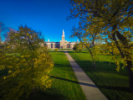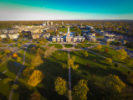Hayes Hall: The Renovation
Inspired design for future architects and planners
If the new Hayes Hall is about anything, it’s about breaking down walls – literally and figuratively – to create an open, transparent and flexible space for dynamic learning and engagement.
Perhaps no other space represents these principles better than the building’s “front door,” a two-story atrium and entry gallery (pictured above). The removal of all non-structural walls turns a dark, awkward corridor into a bright, inviting space that calls upon the occupant to pause and interact with their surroundings. A minimalist design aesthetic lets the walls and structural elements recede into the background as exhibitions of faculty and student work come to the fore. As a venue for public events – exhibitions and receptions – the gallery is a shared space for the school, university and community. The gallery connects to a new quiet study area offering students an informal learning environment.
This design intent is carried throughout the building. Open critique spaces – for example, along a corridor between a studio and seminar room – invite curious passersby to listen and engage. Living and learning landscapes on the second and third floors provide informal gathering spaces and, with pinup-ready walls, opportunity for spontaneous dialogue. Rolling tables and chairs create flexible, collaborative learning environments. The dim corridors of Hayes Halls’ east and west wings are now saturated in natural light by way of glass-walled offices while a third-floor studio with 25-foot ceilings and three walls of windows offers students a bright, open space to create and collaborate.
That such transparency and openness suggests a democratic environment was an intentional design gesture, as the new Hayes Hall brings students together with faculty and administration for the first time under one roof. State-of-the-art technology throughout the building is interwoven into the “experience” of the new Hayes Hall. A full-wall projection system in the atrium and galley and digital displays throughout the building project the school’s culture of research and making. Swivel ceiling lights can turn a blank wall into formal exhibition space. Smart classroom technology accessible to both faculty and students supports the collaborative, problems-based model of studio education.
The renovation has also uncovered new spaces – most notably the fourth floor, which had been closed off for decades. To host studios and critique spaces, the reclaimed attic features exposed wooden trusses and skylights for natural light (and a stellar view of restored Hayes Hall clock tower and cupolas).
On the fourth floor, the original two-story Hayes Hall auditorium has been converted into a 110-seat event hall and lecture space featuring arched windows and a restored curvilinear ceiling. The space will serve as the school’s signature event space.


.jpg.thumb.100.140.jpg)


















